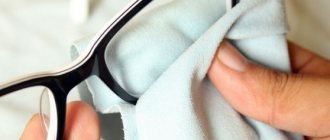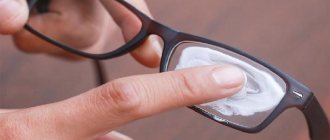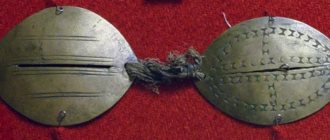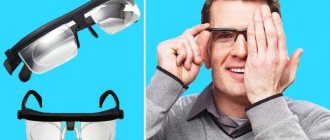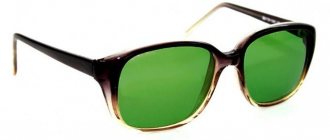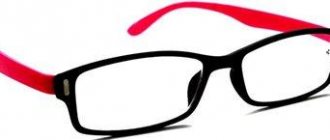Unfortunately, none of us are immune from age-related vision changes. It has long been no secret that people over forty-five years of age are at risk of developing presbyopia (age-related farsightedness). This occurs because the lens loses its ability to change shape to focus on objects at different distances. Difficulty reading small print and difficulty seeing in dim light are the first signs of presbyopia, and if they appear, you should immediately consult an ophthalmologist. In most cases, it is recommended to purchase special reading glasses.
Causes of age-related farsightedness
Normally, in healthy people, a beam of light passes through the pupil, is refracted in the cornea and lens, and is projected onto the retina. It is then that the impulse is correctly deciphered by the brain, and the person clearly sees the surrounding objects.
The main refractive element is the lens. It bends depending on the near or far location of objects. To do this, he needs accommodative muscles. Over time, the quality of metabolism in the muscles decreases and the regenerative function of cells decreases.
Additionally, insoluble protein fractions accumulate in the lens, which reduce its transparency. This is why there is a decrease in visual acuity for near objects. Eyeballs begin to age along with a person.
Types of glasses
There are several types of glasses that patients use when visual acuity decreases in the form of hypermetropia:
- Monofocal. In such models, you can see objects at a distance of no more than 40 cm. They are usually prescribed by ophthalmologists for patients who only want to read or look at a computer monitor with such glasses. They are not applicable for other purposes. It is inconvenient to wear such glasses all day, as you will need to constantly take them off and put them on.
- Bifocal. The focus in such models is bifurcated, with the myopic part located on top and the hypermetropic part below. That is, in the upper part the patient can see objects in the distance, and in the lower part – close up. The optical product is suitable for people who need to use optics all day long. There is no need to remove it at this time. The disadvantage of such models is a sharp transition from myopia to hypermetropia, while the patient’s eyes and head begin to hurt.
- Progressive. They are based on the same principle as bifocals. That is, between the lines of myopia and hypermetropia there is a transitional part. When changing the gaze from near to distant objects, there is no additional load on the patient’s vision. Everything changes smoothly. It takes a long time for people to get used to such optical models.
- Models for lying down reading. They resemble a periscope, that is, a person does not need to bend his neck to read what is written in the book.
- Halves. Glasses are placed over the person's eyes, but he only uses them when moving his gaze down to read or view a close object. The rest of the time he looks over his glasses to see into the distance.
Glasses for vision should be selected not by the patient, but by the doctor after a preliminary diagnostic examination of his vision function.
Parameters of good vision
Normal visual acuity corresponds to 1.0 (100%). Essentially, the eyeball is an optical system in which there are two lenses that refract the image and a visual analyzer - the retina. The eye also consists of a cornea - a strong, spherical, transparent lens with a stable shape, and a lens - an elastic lens capable of changing its shape due to contraction of the ciliary muscle, “accommodating”, that is, adjusting to near and distant objects, focusing the image on retina
The key to good vision is also a certain anatomical length of the eyeball and the sphericity of the refractive lenses.
The average length of an adult human eye is 23.0 mm. A newborn's eye length is 17 mm, the refraction corresponds to an average of sph + 3.5. The eye grows to 23.0 mm by 7-8 years. When growth is delayed, hypermetropia persists. The cause of myopia (myopia) is an anatomically long eye. Myopia appears more often in adolescence, and its progression stops at 18-20 years old, when the body stops growing.
There is another concept in refraction - astigmatism. Its cause is uneven refraction of optical lenses, most often the cornea.
Wearing glasses for refractive error from childhood prevents the progression of visual impairment and prevents the development of amblyopia (lazy eye), especially when visual acuity is different between the eyes. With amblyopia, an irreversible decrease in vision occurs, most often due to the fact that the better-seeing eye takes on the main visual load, while the visual perception of the second eye is irreversibly reduced.
With myopia, hypermetropia and astigmatism, the focus of the image does not fall on the retina, it is shifted and, as a result, a person sees surrounding objects blurry and indistinct. Using the laws of physics, we can improve vision in such cases. Glasses and soft contact lenses help us with this. By creating an additional refractive medium using a spectacle lens, it is possible to correctly focus the image on the retina.
Is it possible to select reading optics yourself?
Ophthalmologists categorically do not recommend choosing any glasses for vision correction on your own. Preliminary measurements are necessary to determine the patient’s individual indicators. For example, the distance between the pupils is different for each person; this is one of the main criteria for making a lens.
Glasses that are sold ready-made in stores have very rough lenses. With their prolonged use, a further decrease in the patient’s visual acuity and overload of the extraocular muscles are possible. Your head may start to hurt. Also, a person can independently select the wrong number of diopters.
Calculation of optical power of reading glasses
To select the optical power that is optimal individually for the patient, it is recommended to consult an ophthalmologist. The indicator is measured using diagnostic tables. In them, the letters change size with each new line. The more lines a person sees, the better the visual acuity.
The ophthalmologist examines each eye individually. First, one organ of vision is closed, all lines are viewed, then the same procedure is performed with the other eye. Each line corresponds to a certain number of dioptre units.
Buying ready-made reading glasses
If, nevertheless, the patient decides to purchase ready-made reading glasses, visual acuity should be checked when using them. The person puts on the optical aid, then looks at the diagnostic chart again. If he sees all the letter lines clearly, this means that the optical power of the glasses is suitable for him.
Also, a person can experience not only farsightedness, but also nearsightedness. This type of vision requires progressive or bifocal glasses. Such optics are not sold on optical shelves; they are selected individually for each patient by an ophthalmologist. This depends on the fact that myopia and hypermetropia may differ in the number of diopters; the optician will not be able to select these numbers on his own.
How is visual acuity determined?
In Russia, a special Sivtsev-Golovin table is most often used to determine visual acuity: from a distance of 5 meters, it is assessed how the eye distinguishes signs of different sizes - optotypes. Due to the fact that optical technology has constantly developed over the past decades, many auxiliary equipment have appeared in the world of visual acuity diagnostics that allow you to select glasses more accurately and quickly. One of them is a sign projector.
The essence of this device is to project slides with ophthalmological tests onto the screen. In addition to the well-known letter tables, a modern projector has more than 40 sets of slides, including a red-green and polarizing filter, a binocular balance test, a stereo test, aniseikonia test and others. They allow not only to carry out visometry - to determine visual acuity, but also to take a number of other indicators, such as binocularity, stereo vision.
Flaws
Ready-made glasses have many disadvantages, which is why ophthalmologists do not recommend them:
- Not suitable for patients who have different visual acuity in the right or left eye.
- During presbyopia, patients often develop astigmatism, that is, an irregular shape of the eyeball. Ready-made glasses are not able to eliminate this defect, so patients experience eye pain and headaches.
- The optical center of the lens will be incorrectly selected, that is, the required middle in which the pupil should be located.
- Lack of additional functions that patients often need. For example, such models are not produced in the form of chameleons, which darken when exposed to bright light, protecting the eyes from ultraviolet radiation.
- Lack of myopia correction function. Ready-made glasses are sold only for one type of visual acuity reduction.
Often people want to buy ready-made corrective glasses, saving some money. But after identifying all the shortcomings, they will need to spend even more to purchase the right models. Therefore, it is recommended to immediately buy individual optics.
average cost
When choosing reading glasses, the price of which has a wide range, you should remember that it depends not only on the manufacturer, but also on the type of lenses and on the material and type of frame .
The frame is often a priority factor in pricing: its cost can reach several tens of thousands of rubles , but this depends more on the prestige of the brand than on the practical advantages of such an element.
For example, designer frames from Hugo Boss and Givenchy cost from 6,500 to 9,000 rubles, and when ordering unique frames, these figures can double or more.
mass-produced plastic or metal frames .
If you wish, you can look for discounted options and special offers, as a result of which for 1000-1500 rubles you can purchase not a frame, but ready-made glasses.
But these are standard models that do not always meet the requirements of a particular patient.
Important! Today you can also buy universal glasses, the optical power of which can be adjusted manually using adjusters on the frame.
The optical range of the lenses of these products is from -6 to +3 diopters, and such optics cost from 3,000 rubles.
It is recommended to study information regarding additional characteristics of lenses. This applies to both ready-made and custom-made options.
In optical shops, the price is determined mainly not on the basis of “branding”, but on the basis of the quality of the lenses. For example, they may not be coated with a protective layer or may not have UV protection.
Such products will cost less, but will not protect the eyes from the harmful effects of ultraviolet radiation, and they will scratch faster if handled carelessly.
Order reading glasses
If a person’s visual acuity is just beginning to decrease due to presbyopia, it is recommended to immediately purchase reading glasses. They can be used not only for reading, but also for use on a computer. Therefore, ophthalmologists often recommend additional spraying.
It will also prevent excessive exposure to radiation from a computer on a person’s eyeballs and eliminate glare.
More and more older people are using computers, so it is recommended not to buy several types of glasses, but to use one model.
If a person has only age-related hypermetropia, it is recommended to select monofocal glasses. If before this moment he had myopia, then the doctor will advise buying bifocal or progressive models. Otherwise, you will need several pairs of glasses, which will be inconvenient to constantly change on your face.
To select the correct reading glasses, consult an ophthalmologist. For diagnostics, not only diagnostic tables are used, but autorefractometry. This is a semi-automatic analyzer that determines the quality of refraction of the eyeballs.
If the patient additionally has any diseases, for example, cataracts, glaucoma, retinal detachment, more serious diagnostic tests will be required:
- checking intraocular pressure;
- fundus examination;
- Ultrasound of the eyeballs;
- ophthalmic perimeter.
Glasses for viewing near objects are an important attribute for people who have begun to develop presbyopia. You can independently select optical aids for vision correction without the help of a doctor. To select high-quality glasses, you should use the services of an ophthalmologist.
How to choose glasses and not make a mistake?
There are a lot of glasses for working on a computer, and often not all of them meet the stated requirements and fulfill their purpose. How are they different?
First of all, if you are offered glasses with special, protective glasses against radiation, you are being deceived. Such glass would be useful in the era of CRT monitors, which today cannot be found even in the computer science classroom of a rural school in the outback. Otherwise, such glasses are completely useless for use with modern monitors. Modern eye protection devices differ significantly.
Let's start with the difference between text on the monitor and printed text.
The text on the monitor is different from the book. Modern displays generate, to a greater extent, rays of the blue-violet spectrum - they are easily scattered in the eye, but have a rather negative impact on its ability to perceive contrast and correctly focus on various objects. As a result, vision is overextended and the optical power of the eye gradually decreases. Also, there is a second spectrum, blue, which overstimulates the brain, which leads to rapid fatigue. Even if your screen has a white sheet with black font, the blue-violet spectrum radiation does not disappear anywhere. If you look at a picture in blue tones, the impact is only enhanced.
By the way, this is a serious reason to change the wallpaper on your desktop and screensaver, if blue or purple colors predominate in it, to green or other, more restrained tones.
How do computer glasses protect your eyes? Protection is carried out in two ways.
- Reflection of rays. A special coating on modern, expensive glasses reflects the rays of the blue-violet spectrum. As a result, the eyes perceive softer tones, the eyes are less strained, which is a positive effect.
- Lenses change the color of the beam. Older models of glasses simply have tinted lenses, and here there is simply a shift of the blue-violet spectrum to the warm spectrum. The efficiency of such models is much lower than that of reflective ones, plus colors are greatly distorted, which is not convenient.
In addition, you should also pay attention that safety glasses for working at a computer can be either without diopters, for normal vision, or with diopters.
Models with lenses without diopters are recommended to be worn by users who work on a PC for more than 4 hours a day.
As a result, computer glasses will help reduce the negative effect, but it should be understood that they are not a panacea. This is only an aid.

